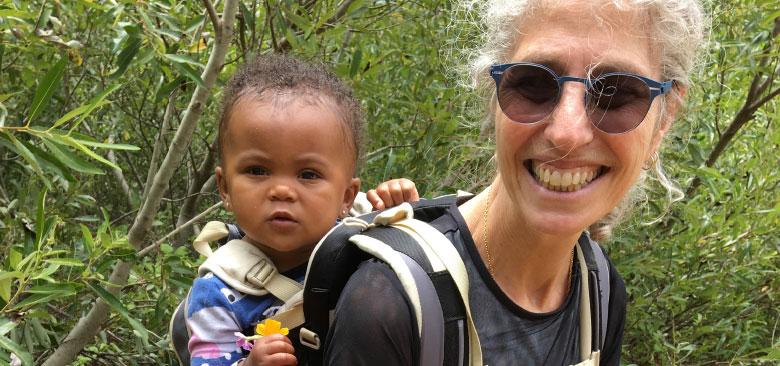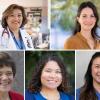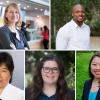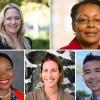
Erica Monasterio hiking in Glen Canyon Park with her grandbaby, Raimee
A Conversation with Erica Monasterio: Reflections on Infusing Health Care with a Social Justice Perspective
In the summer of 2018, Erica Monasterio retired from the UC San Francisco School of Nursing after more than 20 years on the faculty, including lengthy stints co-leading the School’s Diversity in Action (DIVA) committee and directing the School’s Family Nurse Practitioner program.
How did you develop an interest in linking social justice with health care delivery?
Social justice is a family tradition. My grandfather was very involved in Jewish social work in the ’20s, ’30s and ’40s, and I was raised to think about social problems and be engaged in trying to contribute to solutions. In high school I was involved in the antiwar movement, an introduction to activism, which evolved into working in the women’s movement. And the women’s health movement was where I found my footing when I moved out to California in 1973, after high school graduation. I lived in Santa Cruz and wound up being one of the early members of the Santa Cruz Women’s Health Collective. We started the Santa Cruz Women’s Health Center, which is still in existence today. That’s how I got my introduction to health care.
How did that lead to nursing?
The social justice and equity aspects of the women’s health movement attracted me. I also like problem-solving – practical problem-solving – so during that time, I was trying to decide between becoming an auto mechanic or a nurse. There are actually a lot of similarities: What’s the problem? What’s causing the problem? I decided on nursing because I preferred the human contact and interaction with people – and didn’t so much like the smells and grime of being a car mechanic, though I did rebuild my VW van’s engine. I wound up at San Diego City College and San Diego State for my RN, and I’ve been an RN since 1980.
What sort of nursing did you do originally?
I worked in labor and delivery for five years, going to UCLA for my master’s [degree], where I trained as a family nurse practitioner [FNP]. After graduating in 1984, I eventually moved to San Francisco to work in the health department. I fell into adolescent health, working with marginalized youth for the next 14 years, often in non-health care settings, including as co-founder of the Cole Street Youth Clinic.
Adolescents are a good match for me. They don’t have a veneer. I find them fascinating, fun and challenging. You can be real with them, and I’m a direct communicator.
When and how did you begin working at UCSF?
In 1997, I received a joint appointment. The primary appointment was in the Division of Adolescent and Young Adult Medicine, where I also had a clinical practice and participated in the interprofessional training of pediatric residents, nurses and adolescent medicine fellows, and developed the program’s nurse traineeship, as well as teaching at the School of Nursing. When Susan Kools and I developed the Nursing Leadership in Adolescent and Young Adult Health [NLAYAH] program [in 2008], the School of Nursing became my primary appointment.
My other significant role in the School of Nursing was with DIVA, where I was the co-chair for many years. And then in 2013, I took on directorship of the FNP program.
What will stay with you most about the FNP program?
We’ve always been a very cohesive, collegial group – very family-oriented in many ways: mutually supportive and committed to the education of students and maintaining a mission of creating a workforce that reflects and serves the population of California. Our whole department is the same – a great group to work with. We’ve also been very community-oriented. As primary care providers, we have a strong commitment to serving populations that are marginalized and underserved – and so have a strong commitment to, and a long tradition of, training students in community clinics and Federally Qualified Health Centers [FQHCs].
Over the last couple of years, there’s been a huge transition. During this time, support from the department’s leadership and success in getting HRSA [Health Resources and Services Administration] training grants have enabled us to be proactive about planning and bringing in new faculty. I had a year of co-directing with Liz Gatewood, the FNP program’s new director, and we’ve been able to recruit some of the best and brightest of our trainees to come back as faculty.
What have been some of the FNP program’s biggest challenges over the years?
One of the biggest challenges is that the needs of our students have changed, which is a reflection of what I’ve seen in my clinical practice: It’s a difficult world to live in. The stress and mental health issues young people are dealing with have become more prominent. And our students have gotten younger. When I trained as an NP, the students were typically nurses who had worked for some time before getting their master’s [degrees]. Now we have many more MEPN [Master’s Entry Program in Nursing] students; that program has gone from a second-career program to a fast-track first career. Add the pressures of living in San Francisco, economic pressures especially, which can be especially tough for first-generation college students or those with family support responsibilities, and we find that our students have different issues and needs than in the past.
So while we need to maintain standards, we also need to build in the flexibility to accommodate our students’ needs. The days of nursing faculty saying, “Jump,” and students saying, “How high?,” are over. Students’ expectations around their educational experience have changed, so we’ve changed the way we teach. It’s really a partnership, and we’re trying to make that transition with the goal of training the best primary care providers we can train to work with populations most at need. Many of our seminars, for example, are now rooted in problem-based learning, which is a big transition for faculty. It’s a big transition, and we are very committed to making it work, but we’re not fully there yet.
It’s also become more challenging to find preceptors willing to work in these times, so we’ve worked very hard to maintain our relationships and to better prepare and support our preceptors. The ones who commit to training our students want additional training and support; Liz has been instrumental in developing new tools and supporting our preceptors wherever they work, including the Central Valley and rural Northern California.
We’ve also gone from a primarily white student body and faculty to a much more diverse student and faculty group that better reflects our population and our mission. We’ve taken our commitment beyond who we serve to who we train and who is doing the training. And that fits with who I am and with my personal and professional trajectory. That’s the work. Bottom-up and top-down, making sure that we are looking at all levels of the system, not just populations that have needs.
That sensibility also seems to apply to your work with DIVA over the years.
I feel really positive and encouraged that the School of Nursing and DIVA were able to develop an approach to addressing issues that arise in the classroom around inclusion, exclusion, stereotyping and respect. The HEALS [Halt-Engage-Allow-Learn-Synthesize] faculty training modules institutionalize the expectation that we all need training and that we need to ground our work in cultural humility; it’s a lifelong process that requires self-reflection. DIVA and HEALS are an essential piece of our educational endeavor.
Now HEALS may become a campuswide approach; we are already working with [the School of] Dentistry and the Medical Center, and worked with the School of Medicine on its Differences Matter initiative, and I’m hopeful that the School of Nursing will become the training home for HEALS across UCSF. That’s recognition for the work DIVA has done, quietly toiling away over the last 15 years. The timing is right – what’s happening in the country, the activism of students – for us to be equal partners in moving these positive ideas forward. I take satisfaction in looking back and hearing from colleagues about the contribution they think we have made. I feel confident that the principles and work and commitment will continue.
Everyone has mentors, influences. Who were yours?
Some of my influences in adolescent health predate UCSF. Janet Shalwitz, who was director of medical services at Juvenile Hall when I arrived, was a big influence and mentor. In the Division of Adolescent and Young Adult Medicine, there’s our division director, Charlie Irwin. And at the School of Nursing, Susan Kools was an incredible friend and co-conspirator in promoting the work with both adolescent health and DIVA, along with Howard Pinderhughes and Teresa Scherzer.
Plans for retirement?
I will continue doing the work that is closest to my heart. I’ll work as a consultant, helping with training and capacity building for community nonprofits that work on things like violence prevention and health and wellness for adolescents. When my youngest child finishes college, I plan to go with her and my wife to Spain for a year. And I have a 15-month-old grandbaby I adore.



